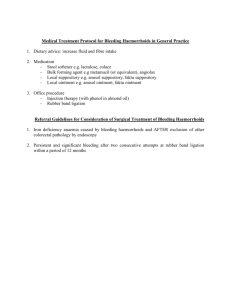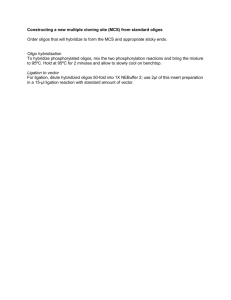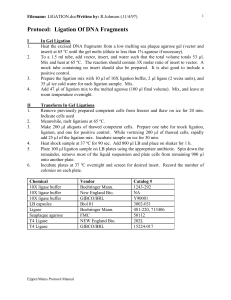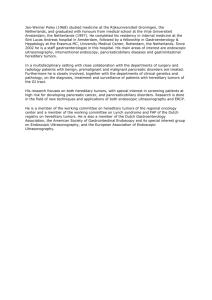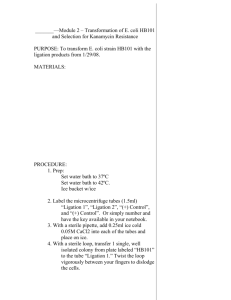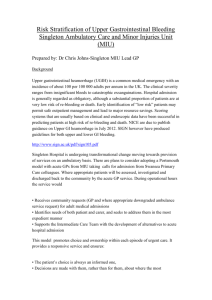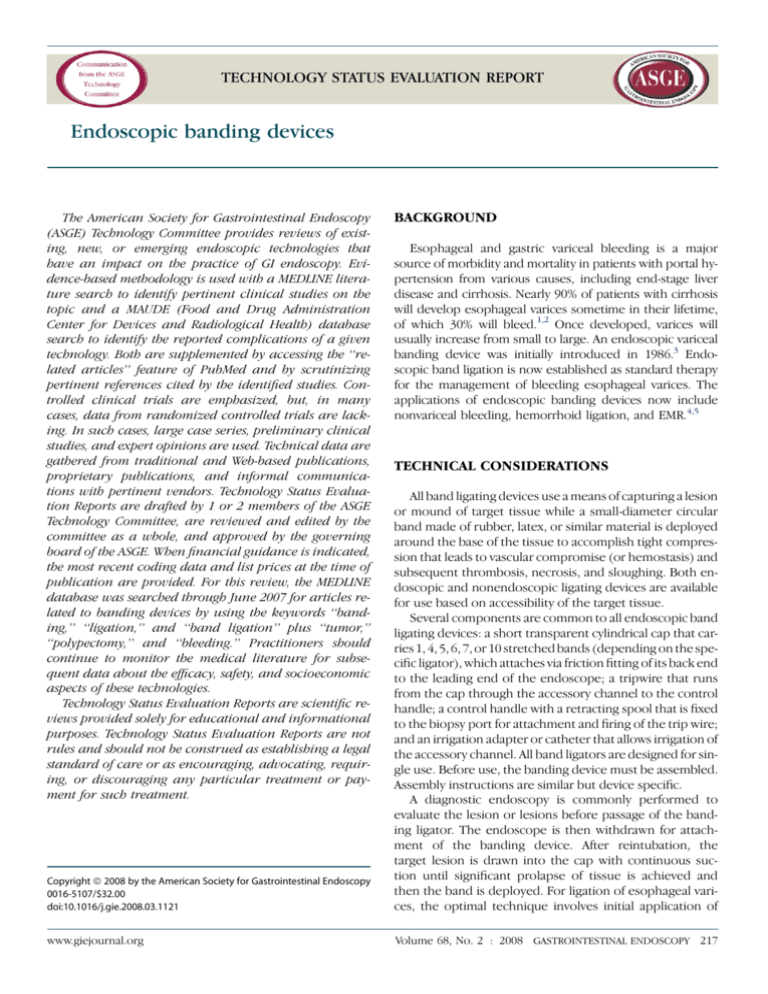
TECHNOLOGY STATUS EVALUATION REPORT
Endoscopic banding devices
The American Society for Gastrointestinal Endoscopy
(ASGE) Technology Committee provides reviews of existing, new, or emerging endoscopic technologies that
have an impact on the practice of GI endoscopy. Evidence-based methodology is used with a MEDLINE literature search to identify pertinent clinical studies on the
topic and a MAUDE (Food and Drug Administration
Center for Devices and Radiological Health) database
search to identify the reported complications of a given
technology. Both are supplemented by accessing the ‘‘related articles’’ feature of PubMed and by scrutinizing
pertinent references cited by the identified studies. Controlled clinical trials are emphasized, but, in many
cases, data from randomized controlled trials are lacking. In such cases, large case series, preliminary clinical
studies, and expert opinions are used. Technical data are
gathered from traditional and Web-based publications,
proprietary publications, and informal communications with pertinent vendors. Technology Status Evaluation Reports are drafted by 1 or 2 members of the ASGE
Technology Committee, are reviewed and edited by the
committee as a whole, and approved by the governing
board of the ASGE. When financial guidance is indicated,
the most recent coding data and list prices at the time of
publication are provided. For this review, the MEDLINE
database was searched through June 2007 for articles related to banding devices by using the keywords ‘‘banding,’’ ‘‘ligation,’’ and ‘‘band ligation’’ plus ‘‘tumor,’’
‘‘polypectomy,’’ and ‘‘bleeding.’’ Practitioners should
continue to monitor the medical literature for subsequent data about the efficacy, safety, and socioeconomic
aspects of these technologies.
Technology Status Evaluation Reports are scientific reviews provided solely for educational and informational
purposes. Technology Status Evaluation Reports are not
rules and should not be construed as establishing a legal
standard of care or as encouraging, advocating, requiring, or discouraging any particular treatment or payment for such treatment.
BACKGROUND
Esophageal and gastric variceal bleeding is a major
source of morbidity and mortality in patients with portal hypertension from various causes, including end-stage liver
disease and cirrhosis. Nearly 90% of patients with cirrhosis
will develop esophageal varices sometime in their lifetime,
of which 30% will bleed.1,2 Once developed, varices will
usually increase from small to large. An endoscopic variceal
banding device was initially introduced in 1986.3 Endoscopic band ligation is now established as standard therapy
for the management of bleeding esophageal varices. The
applications of endoscopic banding devices now include
nonvariceal bleeding, hemorrhoid ligation, and EMR.4,5
TECHNICAL CONSIDERATIONS
Copyright ª 2008 by the American Society for Gastrointestinal Endoscopy
0016-5107/$32.00
doi:10.1016/j.gie.2008.03.1121
All band ligating devices use a means of capturing a lesion
or mound of target tissue while a small-diameter circular
band made of rubber, latex, or similar material is deployed
around the base of the tissue to accomplish tight compression that leads to vascular compromise (or hemostasis) and
subsequent thrombosis, necrosis, and sloughing. Both endoscopic and nonendoscopic ligating devices are available
for use based on accessibility of the target tissue.
Several components are common to all endoscopic band
ligating devices: a short transparent cylindrical cap that carries 1, 4, 5, 6, 7, or 10 stretched bands (depending on the specific ligator), which attaches via friction fitting of its back end
to the leading end of the endoscope; a tripwire that runs
from the cap through the accessory channel to the control
handle; a control handle with a retracting spool that is fixed
to the biopsy port for attachment and firing of the trip wire;
and an irrigation adapter or catheter that allows irrigation of
the accessory channel. All band ligators are designed for single use. Before use, the banding device must be assembled.
Assembly instructions are similar but device specific.
A diagnostic endoscopy is commonly performed to
evaluate the lesion or lesions before passage of the banding ligator. The endoscope is then withdrawn for attachment of the banding device. After reintubation, the
target lesion is drawn into the cap with continuous suction until significant prolapse of tissue is achieved and
then the band is deployed. For ligation of esophageal varices, the optimal technique involves initial application of
www.giejournal.org
Volume 68, No. 2 : 2008 GASTROINTESTINAL ENDOSCOPY 217
Endoscopic banding devices
bands distally, followed by progressive proximal placement of a variable number of bands until all protruding
varices are captured. Starting distally allows for complete
visualization and avoids the potential risk of dislodging
a band during advancement of the endoscope past a previously captured varix. During variceal-band ligation, transient bleeding can occur because of rupture of the varix.
Band ligation may be repeated at 1-week to 4-week intervals until the varices are obliterated.
Endoscopic banding devices that are commercially available include single-band and multiband devices. The only
single-band ligation device (Stiegmann-Goff Bandito;
ConMed Corp, Utica, NY) uses an overtube for repeated
intubation to facilitate placement of multiple bands.
The multiband ligators include the Auto-band Ligator
(Scandimed International, Glostrup, Denmark), the Speedband Superview Super 7 Multiple Band Ligator (Boston
Scientific Corp, Natick, Mass), and the Saeed Multi-band
Ligator (Cook Endoscopy, Winston-Salem, NC). Multiband
ligators do not require the placement of an overtube.
Esophageal band ligation cannot be performed in children who weigh less than 8 kg because of the size of the
ligating tip and the need to use a standard-caliber endoscope. In these patients, sclerotherapy is a satisfactory alternative. For children who weigh between 8 and 10 kg,
the single-band ligating device can usually be passed without the use of an overtube and without obstruction of the
endoscopic view. The multiband ligation devices can be
used in children more than 10 kg in weight.
APPLICATIONS
The most common indication for endoscopic band ligation is for the prevention and treatment of esophageal variceal bleeding.4 Banding can also be used for linear gastric
varices on the most proximal portion of the lesser curve.6
Band ligation using direct rigid anoscopy was originally
developed as a nonsurgical alternative for the treatment of
hemorrhoids. More recently there have been reports on
the use of endoscopic devices that are designed for esophageal variceal ligation.7,8 This has led to the development
of endoscopic devices designed for hemorrhoidal ligation.
Other clinical applications of the endoscopic banding devices include treatment of postpolypectomy bleeding,9-11
arteriovenous malformations,11,12 Mallory-Weiss tears,13
Dieulafoy’s lesions,14,15 blue rubber bleb nevus syndrome,16,17 and diverticular bleeding.18 Endoscopic mucosectomy by using a band ligation device with a snare has
also been used for the removal of esophagogastric19-22
and rectal tumors.23,24
apy.25-30 For the primary prevention of esophageal variceal
bleeding, endoscopic variceal ligation has been shown to
be safer and possibly more effective than nonselective
beta blockers (propranolol or nadolol).31-33 In a meta-analysis of 8 randomized controlled trials that involved 596 patients, band ligation reduced the rate of the first variceal
bleed by 43% compared with the beta-blocker group, although there was no effect on mortality.34
For secondary prevention of esophageal variceal bleeding, endoscopic ligation is shown to be preferable to sclerotherapy, by yielding faster reduction and obliteration of
varices, and by requiring fewer procedures and a lower
rate of complications and rebleeding before eradication.35
In a randomized prospective trial that compared the multiband ligator with the conventional single-band ligator,
the multiband device was associated with a significant reduction in sedation requirement, endoscopic time, and
patient discomfort.25
The combination of endoscopic band ligation and sclerotherapy appears to offer no advantage over band ligation alone in the prevention of rebleeding and in
a reduction in mortality, although combination therapy
is associated with a higher complication rate of esophageal stricture.36,37 Comparisons of transjugular intrahepatic portal systemic shunt (TIPS) to endoscopic band
ligation showed no differences in mortality for up to 2
years.36-38 TIPS is more effective than endoscopic band ligation for the prevention of variceal rebleeding; however,
there is a considerable risk of hepatic encephalopathy.38-40
When compared with standard surgical techniques for
hemorrhoidectomy, endoscopic band ligation has similar
efficacy and complication rates.41 Most studies reveal
long-term success rates of 86% to 95% and may require
fewer treatment sessions compared with band ligation
using rigid surgical instruments.41-44
There are no prospective data or comparative studies
that pertain to band ligation for the management of nonvariceal bleeding or for EMR. The data regarding band ligation for the management of nonvariceal bleeding
conditions, such as post-polypectomy bleeding,9-11 arteriovenous malformations,11,12 Mallory-Weiss tears,13
Dieulafoy’s lesions,14,15 blue rubber bleb nevus syndrome,16,17 and diverticular bleeding,18 are limited to
case reports and nonrandomized prospective clinical studies. Similarly, the data for endoscopic mucosectomy when
using the band ligation device is descriptive only.19-24 Endoscopic mucosectomy with banding devices and purpose
specific devices is reviewed in another technology
report.45
COMPARATIVE STUDIES
SAFETY
Multiple randomized controlled trials of therapy for
acute esophageal variceal bleeding showed endoscopic
band ligation to be superior to endoscopic sclerother-
Common complications associated with banding devices include chest pain, bleeding, stricture formation, aspiration pneumonia, dysphagia, and perforation.37 The
218 GASTROINTESTINAL ENDOSCOPY Volume 68, No. 2 : 2008
www.giejournal.org
Endoscopic banding devices
TABLE 1. Variceal band ligators
ConMed
(Utica, NY)
Manufacturer
Scandimed International
and ConMed
Boston
Scientific
Cook Endoscopy
Name
Stiegmann-Goff and
S-G ClearVue endoscopic
ligators
Auto-Band Ligator
multiple-band ligator
Speedband, SuperView
Super 7 multiple
band ligators*
4, 6, 10 Shooter Saeed
multiband ligators
No. bands per cap
1
5, 7, 10
7
4, 6, 10
Endoscope tip
diameter (mm)
9-11
8.6-11.5
8.6-11.5
8.5-9.2, 8.6-11.3, 9.5-11.5,
9.5-13, 11-14
Band color
Blue
Black
Blue
Black
Band material
Rubber
Latex-free rubber
Neoprene
Natural rubber latex
Costs
Stiegman-Goffy $405
(5 preloaded bands), $535
(10 preloaded bands);
Stiegman-Goff ‘‘Clearvue’’
$450 (5 preloaded bands),
$600 (10 preloaded bands)
$220 (5 bands), $325
(7 bands), $370
(10 bands)
$595 (2 kits/box); $1190
(4 kits/box)
$221 (4 bands), $266
(6 bands), $289 (10 bands)
*Also approved for hemorrhoidal ligation.
yAll prices are per box with 5 kits/box.
TABLE 2. Hemorrhoid and mucosectomy ligators for flexible endoscopes
Manufacturer
Scandimed International
and ConMed
Name
Auto-Band Ligator- Colonic
ShortShot Saeed Hemorrhoidal
Multi-Band Ligator
Duette Multi-Band
Mucosectomy Kit
Application
Hemorrhoids
Hemorrhoids
Mucosectomy
No. bands
5
4
6
Endoscope type or size
11.5-14 mm
Integrated single-use
TriView Anoscope
9.5-13 mm, or 11-14 mm
Cook Medical
Components
Costs
Cook Medical
Includes braided Hex-snare
$160
$50
$295
incidence of these complications is very low.46 Chest pain
associated with band ligation is typically temporary in nature but may require intervention. Esophageal perforation
secondary to ulcer formation or overtube placement has
been reported. Anorectal pain and bleeding are common
complications of hemorrhoidal banding, whereas acute
thrombosis of external hemorrhoids and septic complications, eg, perianal abscess, are less common.43
Latex allergy is a commonly expressed concern pertaining to some banding devices. The U.S. Food and Drug
Administration (FDA) mandates specific washing and leaching steps to reduce the presence of allergenic natural rubber
latex proteins during the manufacture of medical products.47 To date, no cases of death or serious allergic reactions after endoscopic placement of bands that contained
natural latex rubber have been published in the literature.
Mortality because of endoscopic band ligation therapy
has not been reported in the literature. A search of the
FDA MAUDE database48 for adverse events identified
a number of deaths in patients treated with the Speedband Superview Multiband Ligator between December
2000 to March 2001, primarily because of the failure of
the bands to deploy, which prompted an FDA recall. There
are also a number of reports of ‘‘device malfunction’’ in
patients treated with the Rapidfire multiband ligators. In
January 2002, there was an FDA Class I recall of the Rapidfire multiband ligation system because of inadequate chlorination of bands, which caused the bands to become
adherent to each other and not deploy properly. The Rapidfire device is no longer marketed in the United States,
but the Speedband Multiband Ligator has been
remarketed.
www.giejournal.org
Volume 68, No. 2 : 2008 GASTROINTESTINAL ENDOSCOPY 219
Endoscopic banding devices
* Current Procedural Terminology (CPT) is copyright 2008 American
Medical Association. All Rights Reserved. No fee schedules, basic units,
relative values, or related listings are included in CPT. The AMA assumes
no liability for the data contained herein. Applicable FARS/DFARS
restrictions apply to government use.
CPT is a trademark of the American Medical Association.
Current Procedural Terminology ª 2008 American Medical Association. All
Rights Reserved.
3. Van Stiegmann G, Cambre T, Sun JH. A new endoscopic elastic band
ligating device. Gastrointest Endosc 1986;32:230-3.
4. Qureshi W, Adler DG, Davila R, et al. ASGE guideline: the role of endoscopy in the management of variceal hemorrhage, updated July 2005.
Gastrointest Endosc 2005;62:651-5.
5. Nelson DB, Block KP, Bosco JJ, et al. Endoscopic mucosal resection:
May 2000. Gastrointest Endosc 2000;52:860-3.
6. Lo GH, Lai KH, Cheng JS, et al. Prevalence of paraesophageal varices
and gastric varices in patients achieving variceal obliteration by banding ligation and by injection sclerotherapy. Gastrointest Endosc
1999;49:428-36.
7. Bartizal J, Slosberg PA. An alternative to hemorrhoidectomy. Arch Surg
1977;112:534-6.
8. Trowers EA, Gangu U, Rizk R, et al. Endoscopic hemorrhoidal ligation:
preliminary clinical experience. Gastrointest Endosc 1998;48:49-52.
9. Smith RE, Doull J. Treatment of colonic post-polypectomy bleeding
site by endoscopic band ligation. Gastrointest Endosc 1994;40:
499-500.
10. Slivka A, Parsons WG, Carr-Locke DL. Endoscopic band ligation for
treatment of post-polypectomy hemorrhage. Gastrointest Endosc
1994;40:230-2.
11. Abi-Hanna D, Williams SJ, Gillespie PE, et al. Endoscopic band ligation
for non-variceal non-ulcer gastrointestinal hemorrhage. Gastrointest
Endosc 1998;48:510-4.
12. Matsui S, Kamisako T, Kudo M, et al. Endoscopic band ligation for control of nonvariceal upper GI hemorrhage: comparison with bipolar
electrocoagulation. Gastrointest Endosc 2002;55:214-8.
13. Gunay K, Cabioglu N, Barbaros U, et al. Endoscopic ligation for
patients with active bleeding Mallory-Weiss tears. Surg Endosc
2001;15:1305-7.
14. Norton ID, Petersen BT, Sorbi D, et al. Management and long-term
prognosis of Dieulafoy lesion. Gastrointest Endosc 1999;50:762-7.
15. Valera JM, Pino RQ, Poniachik J, et al. Endoscopic band ligation of
bleeding Dieulafoy lesions: the best therapeutic strategy. Endoscopy
2006;38:193-4.
16. Nijhawan S, Kumar D, Joshi A, et al. Endoscopic band ligation for nonvariceal bleed. Indian J Gastroenterol 2004;23:186-7.
17. Fishman SJ, Smithers CJ, Folkman J, et al. Blue rubber bleb nevus
syndrome: surgical eradication of gastrointestinal bleeding. Ann
Surg 2005;241:523-8.
18. Farrell JJ, Graeme-Cook F, Kelsey PB. Treatment of bleeding colonic
diverticula by endoscopic band ligation: an in-vivo and ex-vivo pilot
study. Endoscopy 2003;35:823-9.
19. Lee DK, Lee SW, Kwon SO, et al. Endoscopic mucosectomy using an
esophageal variceal ligation device for minute gastric cancer. Endoscopy 1996;28:386-9.
20. Sakai P, Maluf Filho F, Iryia K, et al. An endoscopic technique for resection of small gastrointestinal carcinomas. Gastrointest Endosc 1996;44:
65-8.
21. Fleischer DE, Wang GQ, Dawsey S, et al. Tissue band ligation followed
by snare resection (band and snare): a new technique for tissue acquisition in the esophagus. Gastrointest Endosc 1996;44:68-72.
22. Wehrmann T, Martchenko K, Nakamura M, et al. Endoscopic resection
of submucosal esophageal tumors: a prospective case series. Endoscopy 2004;36:802-7.
23. Ono A, Fujii T, Saito Y, et al. Endoscopic submucosal resection of rectal
carcinoid tumors with a ligation device. Gastrointest Endosc 2003;57:
583-7.
24. Van Os EC, Gostout CJ, Geller A, et al. Band ligation-assisted
endoscopic resection of a flat rectal adenoma containing infiltrating
adenocarcinoma. Gastrointest Endosc 1997;45:322-4.
25. Wong T, Pereira SP, McNair A, et al. A prospective, randomized comparison of the ease and safety of variceal ligation using a multiband
vs. a conventional ligation device. Endoscopy 2000;32:931-4.
26. Gimson AE, Ramage JK, Panos MZ, et al. Randomised trial of variceal
banding ligation versus injection sclerotherapy for bleeding oesophageal varices. Lancet 1993;342:391-4.
220 GASTROINTESTINAL ENDOSCOPY Volume 68, No. 2 : 2008
www.giejournal.org
FINANCIAL CONSIDERATIONS
All commercially available band ligation devices are
cleared by the FDA for single use only. The costs for
each device vary by manufacturer and are listed in Table 1.
The cost of the hemorrhoidal ligation devices for use with
flexible endoscopy and the mucosectomy device are listed
in Table 2.
The use of band ligation during the performance of an
upper endoscopy can be billed by using the following
Current Procedural Terminology (CPT)* codes: 43205,
Esophagoscopy, rigid or flexible with band ligation of esophageal varices; 43244, Upper gastrointestinal endoscopy including esophagus, stomach, and either the duodenum
and/or jejunum as appropriate, with band ligation of esophageal and/or gastric varices; 43251, Upper gastrointestinal
endoscopy including esophagus, stomach, and either the
duodenum and/or jejunum as appropriate, with removal
of tumor(s), polyp(s), or other lesion(s) by snare technique,
in combination with unlisted code to reflect the banding
portion of procedure 43999, Unlisted procedure, stomach.
For internal hemorrhoid banding, use the code 46934,
Destruction of internal hemorrhoids any method.
SUMMARY
There is now a substantial body of data that suggests
that endoscopic band ligation is a safe and effective treatment for both acute esophageal variceal bleeding and the
prevention of bleeding. Use of band ligation in the management of a number of other bleeding and nonbleeding
conditions also appears to be efficacious.
Abbreviations: ASGE, American Society for Gastrointestinal Endoscopy;
CPT, Current Procedural Terminology; FDA, U.S. Food and Drug
Administration; TIPS, transjugular intrahepatic portal systemic shunt.
REFERENCES
1. Grace ND. Diagnosis and treatment of gastrointestinal bleeding
secondary to portal hypertension. American College of Gastroenterology Practice Parameters Committee. Am J Gastroenterol 1997;92:
1081-91.
2. Prediction of the first variceal hemorrhage in patients with cirrhosis of
the liver and esophageal varices. A prospective multicenter study. The
North Italian Endoscopic Club for the Study and Treatment of Esophageal Varices. N Engl J Med 1988;319:983-9.
Endoscopic banding devices
27. Laine L, el-Newihi HM, Migikovsky B, et al. Endoscopic ligation compared with sclerotherapy for the treatment of bleeding esophageal
varices. Ann Intern Med 1993;119:1-7.
28. Stiegmann GV, Goff JS, Michaletz-Onody PA, et al. Endoscopic sclerotherapy as compared with endoscopic ligation for bleeding esophageal varices. N Engl J Med 1992;326:1527-32.
29. Hou MC, Lin HC, Kuo BI, et al. Comparison of endoscopic variceal injection
sclerotherapy and ligation for the treatment of esophageal variceal hemorrhage: a prospective randomized trial. Hepatology 1995;21:1517-22.
30. Lo GH, Lai KH, Cheng JS, et al. A prospective, randomized trial of sclerotherapy versus ligation in the management of bleeding esophageal
varices. Hepatology 1995;22:466-71.
31. Deschenes M, Barkun AN. Comparison of endoscopic ligation and propranolol for the primary prevention of variceal bleeding. Gastrointest
Endosc 2000;51:630-3.
32. Sarin SK, Lamba GS, Kumar M, et al. Comparison of endoscopic ligation and propranolol for the primary prevention of variceal bleeding.
N Engl J Med 1999;340:988-93.
33. Lo GH, Chen WC, Chen MH, et al. Endoscopic ligation vs. nadolol in the
prevention of first variceal bleeding in patients with cirrhosis. Gastrointest Endosc 2004;59:333-8.
34. Khuroo MS, Khuroo NS, Farahat KL, et al. Meta-analysis: endoscopic
variceal ligation for primary prophylaxis of oesophageal variceal
bleeding. Aliment Pharmacol Ther 2005;21:347-61.
35. Masci E, Stigliano R, Mariani A, et al. Prospective multicenter randomized trial comparing banding ligation with sclerotherapy of esophageal varices. Hepatogastroenterology 1999;46:1769-73.
36. Singh P, Pooran N, Indaram A, et al. Combined ligation and sclerotherapy versus ligation alone for secondary prophylaxis of esophageal variceal bleeding: a meta-analysis. Am J Gastroenterol 2002;97:623-9.
37. Dinning JP, Jaffe PE. Delayed presentation of esophageal perforation
as a result of overtube placement. J Clin Gastroenterol 1997;24:250-2.
38. Rossle M, Deibert P, Haag K, et al. Randomised trial of transjugular-intrahepatic-portosystemic shunt versus endoscopy plus propranolol for
prevention of variceal rebleeding. Lancet 1997;349:1043-9.
39. Pomier-Layrargues G, Villeneuve JP, Deschenes M, et al. Transjugular
intrahepatic portosystemic shunt (TIPS) versus endoscopic variceal
ligation in the prevention of variceal rebleeding in patients with
cirrhosis: a randomised trial. Gut 2001;48:390-6.
40. Sauer P, Hansmann J, Richter GM, et al. Endoscopic variceal ligation
plus propranolol vs. transjugular intrahepatic portosystemic stent
shunt: a long-term randomized trial. Endoscopy 2002;34:690-7.
41. Wehrmann T, Riphaus A, Feinstein J, et al. Hemorrhoidal elastic band
ligation with flexible videoendoscopes: a prospective, randomized
www.giejournal.org
42.
43.
44.
45.
46.
47.
48.
comparison with the conventional technique that uses rigid proctoscopes. Gastrointest Endosc 2004;60:191-5.
Su MY, Tung SY, Wu CS, et al. Long-term results of endoscopic hemorrhoidal ligation: two different devices with similar results. Endoscopy 2003;35:416-20.
Su MY, Chiu CT, Wu CS, et al. Endoscopic hemorrhoidal ligation of
symptomatic internal hemorrhoids. Gastrointest Endosc 2003;58:
871-4.
Fukuda A, Kajiyama T, Arakawa H, et al. Retroflexed endoscopic multiple band ligation of symptomatic internal hemorrhoids. Gastrointest
Endosc 2004;59:380-4.
Kantsevoy SV, Adler DG, Conway JD, et al. Endoscopic mucosal resection and endoscopic submucosal dissection. Gastrointest Endosc
2008;68:11-8.
Schmitz RJ, Sharma P, Badr AS, et al. Incidence and management of
esophageal stricture formation, ulcer bleeding, perforation, and massive hematoma formation from sclerotherapy versus band ligation.
Am J Gastroenterol 2001;96:437-41.
Fast facts on latex for clinicians. Available at: http://www.cookmedical.
com/esc/content/mmedia/19600_0407_Latex_Fast_Facts.pdf. Accessed
November 1, 2007.
Search MAUDE databade. Available at: http://www.accessdata.fda.
gov/scripts/cdrh/cfdocs/cfMAUDE/search.cfm. Accessed December
30, 2007.
Prepared by:
ASGE TECHNOLOGY COMMITTEE
Julia Liu, MD
Bret T. Petersen, MD, Chair
William M. Tierney, MD
Ram Chuttani, MD
James A. DiSario, MD
Joseph M. B. Coffie, MD, NASPGHAN Representative
Daniel S. Mishkin, MD
Raj J. Shah, MD
Lehel Somogyi, MD
Louis Michel Wong Kee Song, MD
This document is a product of the ASGE Technology Committee. This
document was reviewed and approved by the governing board of the
ASGE.
Volume 68, No. 2 : 2008 GASTROINTESTINAL ENDOSCOPY 221


